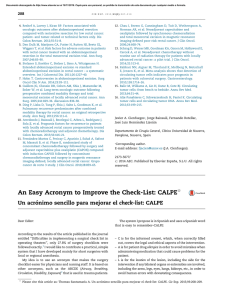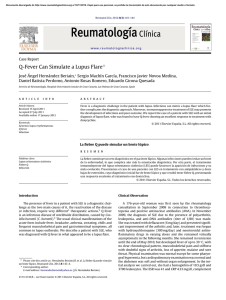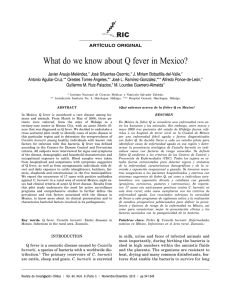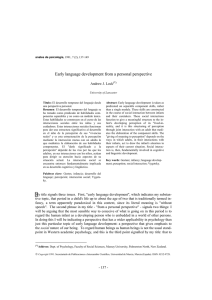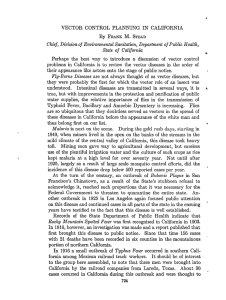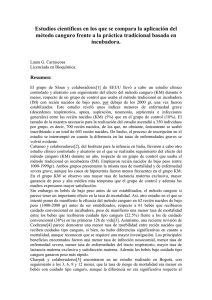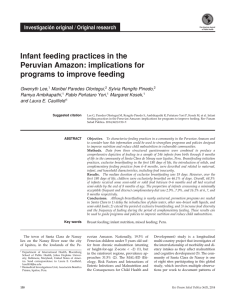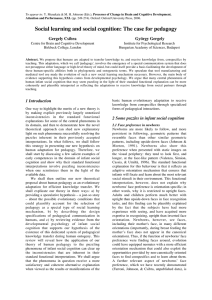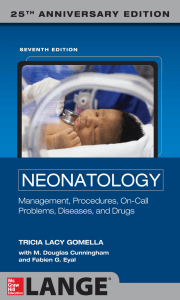Febrile infant (younger than 90 days of age) Definition of fever - UpToDate
Anuncio
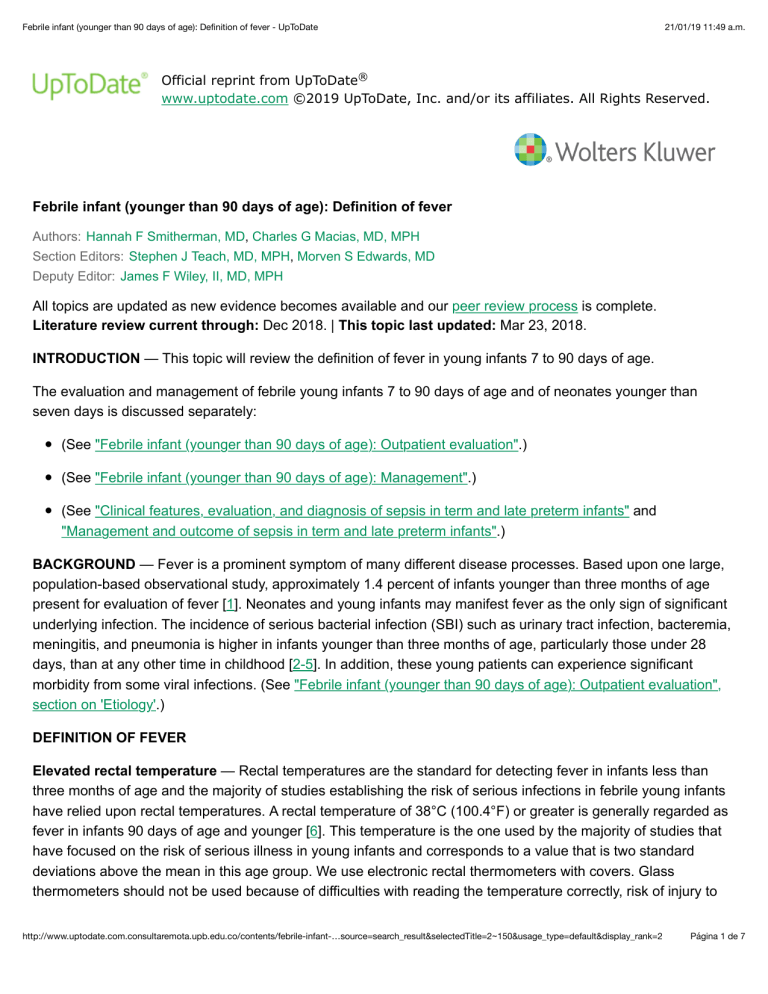
Febrile infant (younger than 90 days of age): Definition of fever - UpToDate 21/01/19 11:49 a.m. Official reprint from UpToDate® www.uptodate.com ©2019 UpToDate, Inc. and/or its affiliates. All Rights Reserved. Febrile infant (younger than 90 days of age): Definition of fever Authors: Hannah F Smitherman, MD, Charles G Macias, MD, MPH Section Editors: Stephen J Teach, MD, MPH, Morven S Edwards, MD Deputy Editor: James F Wiley, II, MD, MPH All topics are updated as new evidence becomes available and our peer review process is complete. Literature review current through: Dec 2018. | This topic last updated: Mar 23, 2018. INTRODUCTION — This topic will review the definition of fever in young infants 7 to 90 days of age. The evaluation and management of febrile young infants 7 to 90 days of age and of neonates younger than seven days is discussed separately: ● (See "Febrile infant (younger than 90 days of age): Outpatient evaluation".) ● (See "Febrile infant (younger than 90 days of age): Management".) ● (See "Clinical features, evaluation, and diagnosis of sepsis in term and late preterm infants" and "Management and outcome of sepsis in term and late preterm infants".) BACKGROUND — Fever is a prominent symptom of many different disease processes. Based upon one large, population-based observational study, approximately 1.4 percent of infants younger than three months of age present for evaluation of fever [1]. Neonates and young infants may manifest fever as the only sign of significant underlying infection. The incidence of serious bacterial infection (SBI) such as urinary tract infection, bacteremia, meningitis, and pneumonia is higher in infants younger than three months of age, particularly those under 28 days, than at any other time in childhood [2-5]. In addition, these young patients can experience significant morbidity from some viral infections. (See "Febrile infant (younger than 90 days of age): Outpatient evaluation", section on 'Etiology'.) DEFINITION OF FEVER Elevated rectal temperature — Rectal temperatures are the standard for detecting fever in infants less than three months of age and the majority of studies establishing the risk of serious infections in febrile young infants have relied upon rectal temperatures. A rectal temperature of 38°C (100.4°F) or greater is generally regarded as fever in infants 90 days of age and younger [6]. This temperature is the one used by the majority of studies that have focused on the risk of serious illness in young infants and corresponds to a value that is two standard deviations above the mean in this age group. We use electronic rectal thermometers with covers. Glass thermometers should not be used because of difficulties with reading the temperature correctly, risk of injury to http://www.uptodate.com.consultaremota.upb.edu.co/contents/febrile-infant-…source=search_result&selectedTitle=2~150&usage_type=default&display_rank=2 Página 1 de 7 Febrile infant (younger than 90 days of age): Definition of fever - UpToDate 21/01/19 11:49 a.m. the patient if they break, and potential for spreading infectious disease. Other measurements — Axillary, temporal artery and tympanic membrane temperatures appear less reliable for detecting fever in young infants when compared to rectal thermometry as the gold standard but may be used when rectal thermometry is contraindicated, such as in patients with neutropenia, bleeding diathesis (eg, thrombocytopenia), or necrotizing enterocolitis. A temperature of 38°C (100.4°F) or greater by methods other than rectal measurement should be regarded as fever and a workup should be initiated. Temperatures measured by other, non-rectal methods that are near 38°C (100.4°F) should be interpreted on a case by case scenario using the overall clinical assessment. Options include serial exams and observation, or, a laboratory evaluation. (See "Fever in infants and children: Pathophysiology and management", section on 'Temperature measurement'.) Observational studies have established the following relationships between rectal temperature and other measurements of body temperature in infants and children as follows (see "Fever in infants and children: Pathophysiology and management", section on 'Temperature measurement'): ● Axillary temperature is most commonly performed as an alternative to rectal temperature in the young infant. It is consistently lower than rectal temperature, but the absolute difference varies too widely for a standard conversion. If a rectal temperature is contraindicated, we prefer to use axillary temperature to determine if a fever is present. ● Systematic reviews have concluded that infrared tympanic membrane thermometry shows insufficient agreement with established methods of core temperature measurement to be used in situations where detection of fever has important clinical implications, such as in febrile young infants. ● Infrared contact and non-contact forehead (temporal artery) thermometers also have contradictory results when compared to rectal temperatures and should not be used to determine the presence of fever in a young infant [7-10]. Readings may be significantly greater or lower than rectal temperature. ● Based upon an observational study in 148 infants younger than three months of age, oral temperature measurement with a pacifier thermometer had a low sensitivity for detection of fever (48 percent) when compared to rectal temperature and a number of infants were unable or unwilling to suck on the device long enough to obtain a reading [7]. Because of the variability from device to device and by site of measurement, we do not suggest altering the reported temperature based on the device used for estimating the rectal temperature. For example, it is not advised to "add a degree" to axillary values but rather report the value with the method of measurement used. As with any measured data, the clinician must then use all clinical findings to interpret the results and to plan an appropriate evaluation. Whenever feasible, we typically measure the rectal temperature of infants initially assessed using other means of temperature measurement. When the measurements are close in time (ie, within 15 to 30 minutes), then we use the rectal temperature to determine if a fever is present. If the measurements are not close in time, then if either measurement indicates a fever, we proceed with an evaluation according to the patient age and clinical findings. (See "Febrile infant (younger than 90 days of age): Management", section on 'Management'.) http://www.uptodate.com.consultaremota.upb.edu.co/contents/febrile-infant-…source=search_result&selectedTitle=2~150&usage_type=default&display_rank=2 Página 2 de 7 Febrile infant (younger than 90 days of age): Definition of fever - UpToDate 21/01/19 11:49 a.m. Caregiver report of fever — Our approach to caregiver report of fever depends upon how the temperature was taken as follows: ● Rectal temperature – It is not uncommon for caregivers to report an elevated temperature in an infant who is afebrile at the time of evaluation. A history of objective fever by rectal temperature at home requires further evaluation according to age and clinical findings, even if the infant is afebrile at the time of presentation. (See "Febrile infant (younger than 90 days of age): Management", section on 'Management'.) In one small observational study of 40 such patients presenting to an emergency department and performed prior to widespread availability of Haemophilus influenzae type b and pneumococcal conjugate vaccines, the risk of bacterial infection, including urinary tract infection, bacteremia, or meningitis was approximately 10 percent [11]. A more recent prospective cohort study performed after routine use of Haemophilus influenzae type b and heptavalent pneumococcal vaccines evaluated 835 infants with a documented fever by rectal temperature at home but who were afebrile when seen in a primary care office and found a risk of about 1 percent for bacteremia or meningitis [12]. Taken together, these studies suggest that the risk of bacterial infection is substantial in infants who are afebrile on presentation but had a fever documented by rectal temperature at home. ● Other measurements – There is limited evidence that addresses the risk of invasive bacterial illness in infants whose caregivers report a fever based upon measurements by less reliable means of temperature assessment such as axillary temperature, contact or non-contact infrared temporal artery temperature, oral pacifier thermometer, or infrared tympanic membrane temperature. Although we recommend rectal temperatures to identify the presence of fever, when caregivers report an elevated temperature within the past 24 hours that is based upon other methods of measurement, our approach is to proceed with an evaluation according to the patient age and clinical findings regardless of the rectal temperature at clinical presentation or the timing between measurements by the caregiver and the medical provider. This approach is in part informed by an understanding that fever is not a static process. In these situations, varying temperature readings over time may reflect natural variability rather than a lack of fever. ● Tactile temperature – When a caregiver reports a tactile (subjective) fever and a rectal temperature shows no fever, our approach is follows: • If the caregiver is calling to report a tactile fever, we ask the caregiver to verify with a rectal temperature at home. If the measured rectal temperature is less than 38°C, there is no documented fever. • If the patient presents without a measured documented temperature of 38°C or greater, the infant may avoid further evaluation if all of the following conditions are met: - No antipyretic medication (eg, acetaminophen) has been given. - History does not suggest an increased risk for bacterial infection (eg, no perinatal risk factors such as prematurity, prolonged rupture of membranes, or maternal colonization with Group B streptococcus; normal behavior and feeding; and no associated difficulty breathing, apneic spells, or color changes). - Appearance and physical examination are normal. http://www.uptodate.com.consultaremota.upb.edu.co/contents/febrile-infant-…source=search_result&selectedTitle=2~150&usage_type=default&display_rank=2 Página 3 de 7 Febrile infant (younger than 90 days of age): Definition of fever - UpToDate 21/01/19 11:49 a.m. - Reliable follow-up within 12 to 24 hours can be arranged. - Caregivers can monitor the rectal temperature at home, understand indications to seek medical attention, and have transportation. - For patients in whom reliable follow-up is not assured and who have not received antipyretic therapy, observation for lack of fever by rectal measurement at one or two additional time points in the department (eg, for one to two feeding cycles) remains an option. It is reassuring if the patient feeds well, remains afebrile, and continues to look well. This time can be used to continue to educate parents on supportive care and signs and symptoms to return. Based upon one very small observational study performed prior to widespread availability of Haemophilus influenzae type b and heptavalent pneumococcal vaccines, only one of 26 patients with tactile fever at home who were afebrile in the emergency department had a serious bacterial illness (urinary tract infection) [11]. The fact that these patients differ with respect to current immunization practice and the possible benefit derived from herd immunity limits interpretation of these findings in a modern-day population where the etiologies of bacterial infection and the invasiveness of the related pathogens have shifted significantly. This uncertainty increases the importance of the clinical assessment and assurance of reliable follow-up. The reliability of other means of temperature assessment when compared to rectal temperatures in young infants is discussed separately. (See 'Other measurements' above and "Fever in infants and children: Pathophysiology and management", section on 'Site and method of measurement'.) Bundling — When ambient temperature and humidity permit normal heat loss (ie, humidity <75 percent, ambient temperature <35°C [95°F]), an elevated rectal temperature >38°C (100.4°F) should not be attributed to bundling in infants 7 to 90 days of age. In addition, a fever >38.5°C (101°F) should not be attributed to bundling regardless of the manner taken. When evaluating an infant who is afebrile by rectal temperature at presentation but had a fever at home, bundling is an important factor to consider if the fever is based upon temperature measurements other than a rectal temperature. (See 'Caregiver report of fever' above.) When ambient temperature and humidity pose a significant threat to heat loss (eg, ambient temperature >35°C [95°F] and/or relative humidity >75 percent), infants who are bundled have a limited ability to acclimate and can have elevated temperatures >38°C (100.4°F) that indicate heat illness. However, infection is still an important consideration. (See "Heat illness (other than heat stroke) in children", section on 'Pathophysiology' and "Heat stroke in children", section on 'Epidemiology'.) Bundling of infants in clothing or blankets generally causes an elevation in skin temperature rather than rectal temperature when ambient conditions permit normal heat loss. As an example, in a randomized trial of 64 infants 11 to 95 days of age, rectal temperature after one hour was not significantly different between bundled and unbundled infants but mean skin temperature was (1.2°C higher in bundled infants) [13]. Thus, bundled young infants outside of the newborn period may feel warm but typically their rectal temperature will reflect their true core temperature. Again, this stresses the importance of using rectal measurements in young febrile infants rather than temporal artery, axillary, or other methods of temperature assessment which may be more impacted by alterations in skin temperature. http://www.uptodate.com.consultaremota.upb.edu.co/contents/febrile-infant-…source=search_result&selectedTitle=2~150&usage_type=default&display_rank=2 Página 4 de 7 Febrile infant (younger than 90 days of age): Definition of fever - UpToDate 21/01/19 11:49 a.m. SOCIETY GUIDELINE LINKS — Links to society and government-sponsored guidelines from selected countries and regions around the world are provided separately. (See "Society guideline links: Febrile young infants (younger than 90 days of age)".) INFORMATION FOR PATIENTS — UpToDate offers two types of patient education materials, "The Basics" and "Beyond the Basics." The Basics patient education pieces are written in plain language, at the 5th to 6th grade reading level, and they answer the four or five key questions a patient might have about a given condition. These articles are best for patients who want a general overview and who prefer short, easy-to-read materials. Beyond the Basics patient education pieces are longer, more sophisticated, and more detailed. These articles are written at the 10th to 12th grade reading level and are best for patients who want in-depth information and are comfortable with some medical jargon. Here are the patient education articles that are relevant to this topic. We encourage you to print or e-mail these topics to your patients. (You can also locate patient education articles on a variety of subjects by searching on "patient info" and the keyword(s) of interest.) ● Basics topic (see "Patient education: Fever in babies younger than 3 months (The Basics)") ● Beyond the Basics topic (see "Patient education: Fever in children (Beyond the Basics)") SUMMARY ● Fever in neonates and infants younger than three months (90 days) of age is defined as a rectal temperature ≥38ºC (100.4ºF). Rectal temperatures are the standard for detecting fever in these infants and the majority of studies establishing the risk of serious infections in febrile young infants have relied upon rectal temperatures. (See 'Definition of fever' above and 'Elevated rectal temperature' above.) ● Axillary, temporal artery and tympanic membrane temperatures appear less reliable for detecting fever in young infants when compared to rectal thermometry as the gold standard but may be used when rectal thermometry is contraindicated, such as in patients with neutropenia, bleeding diathesis (eg, thrombocytopenia), or necrotizing enterocolitis. (See 'Other measurements' above.) ● A reliable caretaker report of fever should be carefully evaluated, even if the infant is afebrile at presentation as follows (see 'Caregiver report of fever' above): • A history of objective fever by rectal temperature requires further evaluation even if the infant is afebrile at the time of presentation. • Although we recommend rectal temperatures to identify the presence of fever, when caregivers report an elevated temperature within the past 24 hours that is based upon other methods of measurement such as axillary temperature, contact or non-contact infrared temporal artery temperature, oral pacifier thermometer, or infrared tympanic membrane temperature, our approach is to proceed with an evaluation according to the patient age and clinical findings regardless of the rectal temperature at clinical presentation or the timing between measurements by the caregiver and the medical provider. • An afebrile infant with a reported history of subjective (tactile) fever may avoid laboratory testing if all of http://www.uptodate.com.consultaremota.upb.edu.co/contents/febrile-infant-…source=search_result&selectedTitle=2~150&usage_type=default&display_rank=2 Página 5 de 7 Febrile infant (younger than 90 days of age): Definition of fever - UpToDate 21/01/19 11:49 a.m. the following conditions are met: - Rectal temperature is normal. - No antipyretic medication (eg, acetaminophen) has been given. - History does not suggest an increased risk for bacterial infection (eg, no perinatal risk factors such as prematurity, prolonged rupture of membranes, recent antibiotics, or maternal colonization with Group B streptococcus; normal behavior and feeding; and no associated difficulty breathing, apneic spells, or color changes). - Appearance and physical examination are normal. - Reliable follow-up within 12 to 24 hours can be arranged. - Caregivers can monitor the rectal temperature at home, understand indications to seek medical attention, and have transportation. ● An elevated rectal temperature should not be attributed to bundling in young infants 7 to 90 days of age when ambient conditions permit normal heat loss. In addition, a fever >38.5ºC (101ºF) should not be attributed to bundling regardless of the manner taken. (See 'Bundling' above.) Use of UpToDate is subject to the Subscription and License Agreement. REFERENCES 1. Greenhow TL, Hung YY, Pantell RH. Management and Outcomes of Previously Healthy, Full-Term, Febrile Infants Ages 7 to 90 Days. Pediatrics 2016; 138. 2. Maniaci V, Dauber A, Weiss S, et al. Procalcitonin in young febrile infants for the detection of serious bacterial infections. Pediatrics 2008; 122:701. 3. Kadish HA, Loveridge B, Tobey J, et al. Applying outpatient protocols in febrile infants 1-28 days of age: can the threshold be lowered? Clin Pediatr (Phila) 2000; 39:81. 4. Baker MD, Bell LM. Unpredictability of serious bacterial illness in febrile infants from birth to 1 month of age. Arch Pediatr Adolesc Med 1999; 153:508. 5. Bachur RG, Harper MB. Predictive model for serious bacterial infections among infants younger than 3 months of age. Pediatrics 2001; 108:311. 6. Hui C, Neto G, Tsertsvadze A, et al. Diagnosis and Management of Febrile Infants (0-3 months). Evidence Report/Technology Assessment No. 205 (Prepared by the University of Ottawa: Evidence-based Practice C enter under Contract No. HHSA 290-2007-10059-I). AHRQ Publication No. 12-E004-EF. Rockville, MD: Ag ency for Healthcare Research and Quality. March 2012. Available at http://www.ahrq.gov/research/findings/ evidence-based-reports/febrinftp.html (Accessed August 3, 2015) 7. Callanan D. Detecting fever in young infants: reliability of perceived, pacifier, and temporal artery temperatures in infants younger than 3 months of age. Pediatr Emerg Care 2003; 19:240. http://www.uptodate.com.consultaremota.upb.edu.co/contents/febrile-infant-…source=search_result&selectedTitle=2~150&usage_type=default&display_rank=2 Página 6 de 7 Febrile infant (younger than 90 days of age): Definition of fever - UpToDate 21/01/19 11:49 a.m. 8. Non-contact thermometers for detecting fever: A review of clinical effectiveness. Rapid Response Report: S ummary with Critical Appraisal. Ottawa (ON): Canadian Agency for Drugs and Technologies in Health. 201 4 PMID: 25520984. 9. Teran CG, Torrez-Llanos J, Teran-Miranda TE, et al. Clinical accuracy of a non-contact infrared skin thermometer in paediatric practice. Child Care Health Dev 2012; 38:471. 10. Fortuna EL, Carney MM, Macy M, et al. Accuracy of non-contact infrared thermometry versus rectal thermometry in young children evaluated in the emergency department for fever. J Emerg Nurs 2010; 36:101. 11. Bonadio WA, Hegenbarth M, Zachariason M. Correlating reported fever in young infants with subsequent temperature patterns and rate of serious bacterial infections. Pediatr Infect Dis J 1990; 9:158. 12. Pantell RH, Newman TB, Bernzweig J, et al. Management and outcomes of care of fever in early infancy. JAMA 2004; 291:1203. 13. Grover G, Berkowitz CD, Lewis RJ, et al. The effects of bundling on infant temperature. Pediatrics 1994; 94:669. Topic 6073 Version 20.0 Contributor Disclosures Hannah F Smitherman, MD Nothing to disclose Charles G Macias, MD, MPH Nothing to disclose Stephen J Teach, MD, MPH Nothing to disclose Morven S Edwards, MD Grant/Research/Clinical Trial Support: Pfizer [Group B Streptococcus]. James F Wiley, II, MD, MPH Nothing to disclose Contributor disclosures are reviewed for conflicts of interest by the editorial group. When found, these are addressed by vetting through a multi-level review process, and through requirements for references to be provided to support the content. Appropriately referenced content is required of all authors and must conform to UpToDate standards of evidence. Conflict of interest policy http://www.uptodate.com.consultaremota.upb.edu.co/contents/febrile-infant-…source=search_result&selectedTitle=2~150&usage_type=default&display_rank=2 Página 7 de 7
